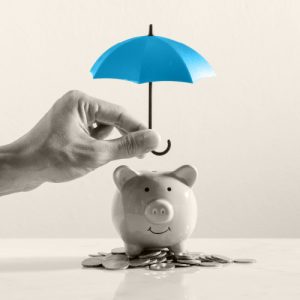Painless Ways to Add to Your Rainy Day Fund
 Establishing a Rainy Day Fund
Establishing a Rainy Day Fund
Every family should have a rainy day fund to protect itself against unpleasant surprises. It’s important to know how much to put away and how to painlessly add to your fund.
As you build your career and your family, your top financial priority should be to accumulate four-to-six months of expenses in a rainy day fund. Here are some tips to prepare.
Change your withholding. Many folks look forward to a federal tax refund every year, but that’s not a good deal. In effect, you’re lending money to Uncle Sam, interest-free. Instead, reduce your withholding and put the extra pay into your emergency savings account. Ask your bank to automatically transfer a fixed amount every paycheck into your savings account. Use the IRS Tax Withholding Estimator (www.irs.gov/individuals/tax-withholding-estimator) to be sure you don’t reduce your withholding too much.
Bank your credit card cashback. Many credit cards offer generous cashback rewards when you use the card to make purchases. In addition, most offer an introductory bonus when you purchase a specified amount during the first three months. All that cashback can help plump up your emergency fund. If you’re shopping around for a new card, watch out for annual fees and high interest rates that reduce the allure of cashback rewards.
Bank your windfalls. Even if you reduce your withholding, circumstances may conspire to provide you a tax refund. You can put it directly into your emergency fund, along with other unexpected windfalls, large or small. Include items like work bonuses, birthday checks, lottery winnings, and stock dividends. You might be pleasantly surprised to see how consistently saving your extra money can build up your emergency fund without you breaking a sweat.
Review your monthly expenses. Don’t overpay for items like bank accounts, mobile phone service, monthly subscription services, or cable. For example, perhaps your bank hits you with overdraft fees or charges you for not maintaining a minimum balance. Try finding another bank or credit union with lower fees and apply the savings to your rainy day fund. Similarly, check your cable and phone bills to see if you are paying for services or products you don’t need Monthly subscription services have become popular and typically offer an inexpensive or free trial offer, However, once your trial is over you will be charged full price. Putting a reminder on your calendar a few days before your trial ends can prompt you to cancel the service if you are no longer interested.
An emergency fund is just the beginning. Once you have your emergency fund looking good, turn your attention to other important priorities, such as your retirement plan, a college fund for your children, and investing in a well-constructed portfolio. Contact me today to start working on an integrated set of financial plans that will serve your current and long-term needs.